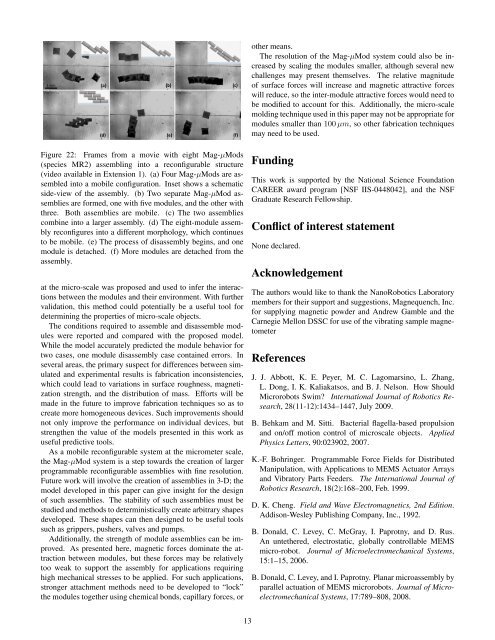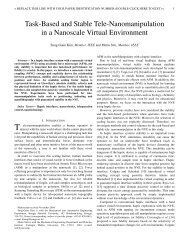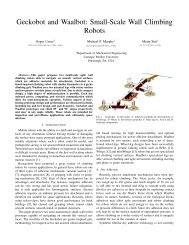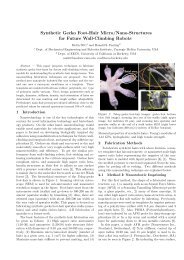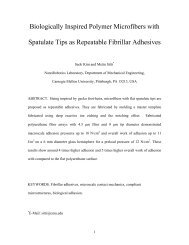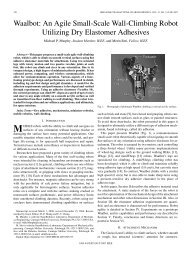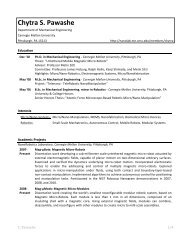Assembly and Disassembly of Magnetic Mobile Micro-Robots ...
Assembly and Disassembly of Magnetic Mobile Micro-Robots ...
Assembly and Disassembly of Magnetic Mobile Micro-Robots ...
You also want an ePaper? Increase the reach of your titles
YUMPU automatically turns print PDFs into web optimized ePapers that Google loves.
other means.<br />
The resolution <strong>of</strong> the Mag-µMod system could also be increased<br />
by scaling the modules smaller, although several new<br />
challenges may present themselves. The relative magnitude<br />
<strong>of</strong> surface forces will increase <strong>and</strong> magnetic attractive forces<br />
will reduce, so the inter-module attractive forces would need to<br />
be modified to account for this. Additionally, the micro-scale<br />
molding technique used in this paper may not be appropriate for<br />
modules smaller than 100 µm, so other fabrication techniques<br />
may need to be used.<br />
Figure 22: Frames from a movie with eight Mag-µMods<br />
(species MR2) assembling into a reconfigurable structure<br />
(video available in Extension 1). (a) Four Mag-µMods are assembled<br />
into a mobile configuration. Inset shows a schematic<br />
side-view <strong>of</strong> the assembly. (b) Two separate Mag-µMod assemblies<br />
are formed, one with five modules, <strong>and</strong> the other with<br />
three. Both assemblies are mobile. (c) The two assemblies<br />
combine into a larger assembly. (d) The eight-module assembly<br />
reconfigures into a different morphology, which continues<br />
to be mobile. (e) The process <strong>of</strong> disassembly begins, <strong>and</strong> one<br />
module is detached. (f) More modules are detached from the<br />
assembly.<br />
at the micro-scale was proposed <strong>and</strong> used to infer the interactions<br />
between the modules <strong>and</strong> their environment. With further<br />
validation, this method could potentially be a useful tool for<br />
determining the properties <strong>of</strong> micro-scale objects.<br />
The conditions required to assemble <strong>and</strong> disassemble modules<br />
were reported <strong>and</strong> compared with the proposed model.<br />
While the model accurately predicted the module behavior for<br />
two cases, one module disassembly case contained errors. In<br />
several areas, the primary suspect for differences between simulated<br />
<strong>and</strong> experimental results is fabrication inconsistencies,<br />
which could lead to variations in surface roughness, magnetization<br />
strength, <strong>and</strong> the distribution <strong>of</strong> mass. Efforts will be<br />
made in the future to improve fabrication techniques so as to<br />
create more homogeneous devices. Such improvements should<br />
not only improve the performance on individual devices, but<br />
strengthen the value <strong>of</strong> the models presented in this work as<br />
useful predictive tools.<br />
As a mobile reconfigurable system at the micrometer scale,<br />
the Mag-µMod system is a step towards the creation <strong>of</strong> larger<br />
programmable reconfigurable assemblies with fine resolution.<br />
Future work will involve the creation <strong>of</strong> assemblies in 3-D; the<br />
model developed in this paper can give insight for the design<br />
<strong>of</strong> such assemblies. The stability <strong>of</strong> such assemblies must be<br />
studied <strong>and</strong> methods to deterministically create arbitrary shapes<br />
developed. These shapes can then designed to be useful tools<br />
such as grippers, pushers, valves <strong>and</strong> pumps.<br />
Additionally, the strength <strong>of</strong> module assemblies can be improved.<br />
As presented here, magnetic forces dominate the attraction<br />
between modules, but these forces may be relatively<br />
too weak to support the assembly for applications requiring<br />
high mechanical stresses to be applied. For such applications,<br />
stronger attachment methods need to be developed to “lock”<br />
the modules together using chemical bonds, capillary forces, or<br />
Funding<br />
This work is supported by the National Science Foundation<br />
CAREER award program [NSF IIS-0448042], <strong>and</strong> the NSF<br />
Graduate Research Fellowship.<br />
Conflict <strong>of</strong> interest statement<br />
None declared.<br />
Acknowledgement<br />
The authors would like to thank the NanoRobotics Laboratory<br />
members for their support <strong>and</strong> suggestions, Magnequench, Inc.<br />
for supplying magnetic powder <strong>and</strong> Andrew Gamble <strong>and</strong> the<br />
Carnegie Mellon DSSC for use <strong>of</strong> the vibrating sample magnetometer<br />
References<br />
J. J. Abbott, K. E. Peyer, M. C. Lagomarsino, L. Zhang,<br />
L. Dong, I. K. Kaliakatsos, <strong>and</strong> B. J. Nelson. How Should<br />
<strong>Micro</strong>robots Swim International Journal <strong>of</strong> Robotics Research,<br />
28(11-12):1434–1447, July 2009.<br />
B. Behkam <strong>and</strong> M. Sitti. Bacterial flagella-based propulsion<br />
<strong>and</strong> on/<strong>of</strong>f motion control <strong>of</strong> microscale objects. Applied<br />
Physics Letters, 90:023902, 2007.<br />
K.-F. Bohringer. Programmable Force Fields for Distributed<br />
Manipulation, with Applications to MEMS Actuator Arrays<br />
<strong>and</strong> Vibratory Parts Feeders. The International Journal <strong>of</strong><br />
Robotics Research, 18(2):168–200, Feb. 1999.<br />
D. K. Cheng. Field <strong>and</strong> Wave Electromagnetics, 2nd Edition.<br />
Addison-Wesley Publishing Company, Inc., 1992.<br />
B. Donald, C. Levey, C. McGray, I. Paprotny, <strong>and</strong> D. Rus.<br />
An untethered, electrostatic, globally controllable MEMS<br />
micro-robot. Journal <strong>of</strong> <strong>Micro</strong>electromechanical Systems,<br />
15:1–15, 2006.<br />
B. Donald, C. Levey, <strong>and</strong> I. Paprotny. Planar microassembly by<br />
parallel actuation <strong>of</strong> MEMS microrobots. Journal <strong>of</strong> <strong>Micro</strong>electromechanical<br />
Systems, 17:789–808, 2008.<br />
13


